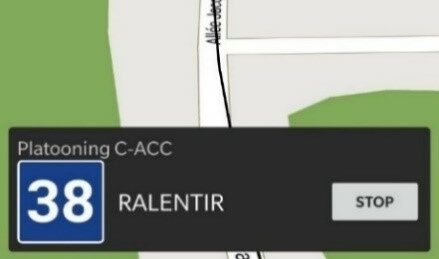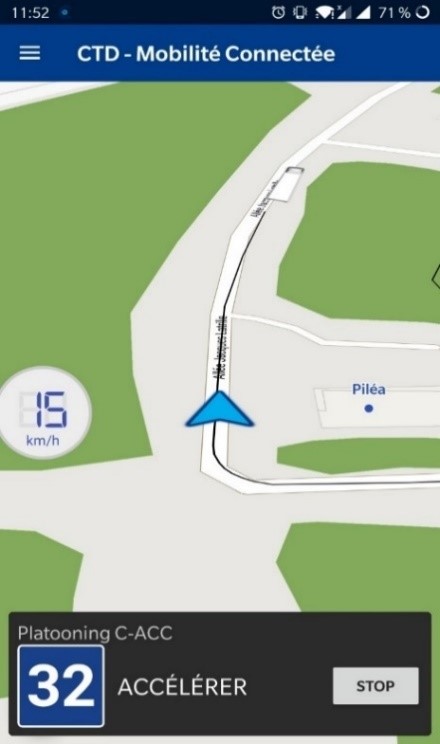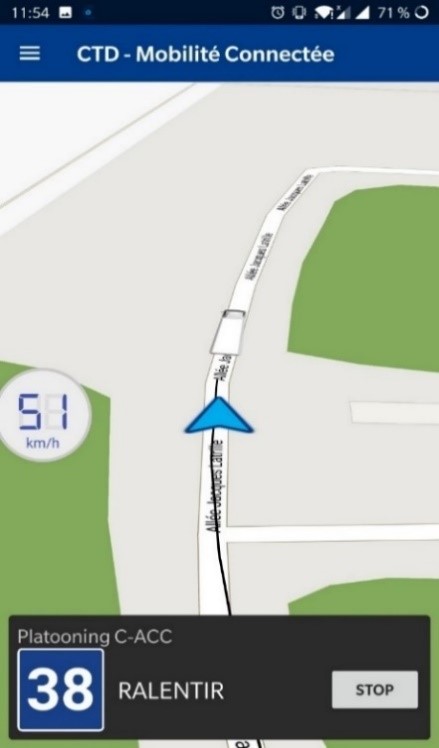Description of the service
One of the first experimentation in this zone is the Platooning Connected and Adaptative Cruise Control. Platooning C-ACC is a service that aims to facilitate the platooning of trucks on the highway. The trucks equipped with the service communicate together by sending information about their position and speed. They also receive and use this information to determine the adequate speed needed to create a platoon with them. This service aims to increase security, particularly by controlling the longitudinal distance between trucks, in case of a braking event for example.
The service will monitor the speed needed to maintain a platoon with reasonable distance between trucks, and act on the Cruise Control feature if applicable, using a connection to the truck’s CAN bus.
Characteristics of the service
The Platooning C-ACC is a new proof of concept service that has been demonstrated on a different geographical area (highway). This is an innovative service for Bordeaux Deployment site, as this is the first time a service can directly be used to control a vehicle ACC programmatically. This is a new step for demonstration regarding autonomous vehicles using C-ITS technologies.
Executed scenario
The service uses the ETSI CAM message. The CAM message is broadcasted by each truck and mainly contains:
- The current location of the truck
- The current speed and heading of the truck
- The history of positions (i.e. PathHistory DE)
The service can work using two different technologies:
- ITS-G5: The CAM message is broadcasted by an OBU with ITS-G5 capabilities. The CAM frequency is 10 Hz (matches the common GPS frequency in OBUs)
- Cellular: The CAM message is sent to other vehicles using the GeoMessaging protocol (MQTT communication with tile system). The CAM frequency is 1 Hz (matches the common GPS frequency in 4G devices)
At each time, the application knows which trucks are around, by filtering all CAM messages on the « stationType » DE. The station type must be « lightTruck » or « heavyTruck ». CAM messages that have a different value are discarded for the following processing.
To determine which trucks are willing to establish a platoon, the application will filter only CAM messages that have a « vehicleRole » set to « specialTransport ».
To determine the trucks that are ahead, the application will map-match its own location on the other trucks « pathHistory ». The map-matching algorithm gives the distance to the truck. This distance is used to know the order of the trucks ahead.
To determine the trucks that are behind, the application will map-match the other trucks location on its own « pathHistory ». The map-match distance is also used to know the order of the trucks behind.
At this point, the application has a list of stations, sorted in the same order that trucks are located on the road. This list will be used to compute a speed advice.
To compute the speed advice, the application uses some constants, that are:
- INTERVAL (in meters): the distance that the driver wants to keep with the vehicle above.
- MAX_SPEED (in km/h): the maximum speed allowed on the road for this type of vehicle.
- MIN_SPEED (in km/h): the minimum speed wanted for the platoon. Any vehicle driving lower will be « abandoned »
Three different advices can be computed by the application:
- DECELERATE: This advice is given in the following cases
o When the distance between Vego and Va1 is lower than INTERVAL -5%. In that case, the speed advice is the speed of Va1 -5%
o When the distance between Vego and Vb1 is higher than INTERVAL * 2 and the speed of Vb1 is at least Vego / 10 lower than the speed of Vego but higher than MIN_SPEED. In that case, the speed advice is the speed of Vb1. - ACCELERATE: This advice is given in the following cases
o When the distance between Vego and Va1 is higher than INTERVAL +5%. In that case, the speed advice is the speed of Va1.
o When Vego is the first truck of the platoon, current speed is not the maximum speed, the distance between Vego and Vb1 is within INTERVAL ±5%, and the speed of Vb1 is within Vego speed ±5%. - MAINTAIN_SPEED: This advice is given in any other case.
The speed advice computed is then displayed to the driver, with the corresponding message.
On the left screenshot, we can see that the truck is too far behind the first truck of the platoon. The speed advice is to accelerate to 32 km/h, in order to come closer to the truck ahead and maintain the platoon.
The second screenshot happens a bit later. The truck followed the advice to accelerate, but the truck ahead had to brake for a miscellaneous reason. The speed advice is now to slow down, because the distance to the truck ahead is not long enough and safety in case of hard braking is not guaranteed. If the application is connected with the vehicle’s CAN bus, a CAN instruction containing the target speed is sent to the Cruise-Control unit.



